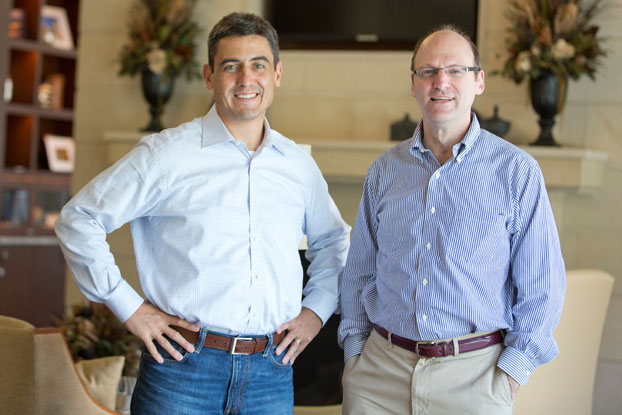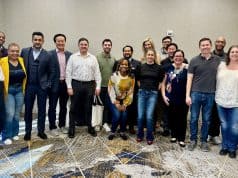 Jeff Busse, associate professor of finance, and Jim Minnick 99EvMBA, founder and CEO of eVestment, first crossed paths in 1998. Busse was teaching his first Emory course—International Finance—and Minnick was finishing his Evening MBA and planning the Cobb County, GA-based business that is now one of the largest institutional investment data and analytics companies in the world. Busse and Minnick caught up recently over coffee in the Oxford Building’s living room on the Emory campus.
Jeff Busse, associate professor of finance, and Jim Minnick 99EvMBA, founder and CEO of eVestment, first crossed paths in 1998. Busse was teaching his first Emory course—International Finance—and Minnick was finishing his Evening MBA and planning the Cobb County, GA-based business that is now one of the largest institutional investment data and analytics companies in the world. Busse and Minnick caught up recently over coffee in the Oxford Building’s living room on the Emory campus.
Busse: Welcome back to campus. Since graduating, you’ve launched your own company. Tell us about your path from Emory to where you are today.
Minnick: I was working for a consulting firm while at Goizueta, and the first time I even thought about starting a business was in my Evening MBA classes, especially with exposure to people who made me think about opportunities other industries had already leveraged. Advances in technology and the advent of the Internet were influencing how people collected information and did investment analytics. So in late 1999, two business partners; my wife, Karen; and I started drafting a business plan. In June 2000, we formally launched the business.
Busse: You found a way to converge these emerging forces?
Minnick: That’s right. eVestment crunches data from asset managers around the globe for the benefit of institutional investors, including portfolio returns, risks, and investment styles. Investors use the data to review the performance of their current asset managers and seek new asset managers for additional investments.
Busse: Investing and entrepreneurship both involve risk. How has your business weathered the economic storms? One would think that people in the money management industry need data regardless of whether the market is up or down.
Minnick: We think of our business as both an investment company and a technology company. Volatility, in general, is good for us. When markets are up, everyone has a good track record to market to potential investors, so they need more tools to distinguish themselves. When markets are down, it’s about being able to use tools and data to identify and avoid various risks and exposures.
Busse: So how do you continue to set yourself apart? Is it through user interfaces or the ways people look at or manipulate the data?
Minnick: Actually, it’s both. We develop great software and simply have a lot more information than others have. In addition, we spend a lot of time talking with our clients about the globalization of investing. Given your international finance background, do you think that trend is here to stay?
Busse: The market sure seems to indicate so. Several decades ago there was a huge home bias, where people would stick with investments in their local country. Over time we’ve seen that loosen up quite a lot. Traditionally, the argument for investing internationally was that it helped diversify a portfolio, because returns weren’t highly correlated from one country to the next. We see a lot less of that benefit as globalization has taken hold. Correlations across economies and stock markets are a lot higher these days.
Minnick: So ten years from now, where is someone going to go to get uncorrelated exposure?
Busse: Maybe the frontier markets, such as Africa or parts of the Middle East. Time will tell. With all the data your firm collects, are you able to get an early read on trends such as when people start looking to invest globally?
Minnick: Sure, especially with the sophisticated information available now. For example, if we see a significant increase in interest on our site in emerging markets, that’s a precursor to where asset flows are going to go. If returns are down and you see a lot of activity, that’s usually a precursor for people starting to withdraw their money.
Speaking of trends, we’ve observed that institutional investors are looking to get more aggressive with hedge funds. Your recent research examines investment management and fund size as a function of performance. Are there trade-offs or economies of scale?
Busse: Our focus has been on mutual funds rather than hedge funds. We find a distinct benefit to small funds in terms of performance, as they have the opportunity to earn higher investment returns by investing in less liquid, smaller cap stocks. Large funds have a hard time transacting less liquid names, because their large trades move the market away from their ideal price before the trade is completed. Hedge funds are more flexible in terms of strategies, so they might be able to overcome some of the obstacles mutual funds face. As far as managers go, the more assets under management, the bigger the paycheck, so they don’t mind having a large asset pool to invest.
Minnick: Is there an optimal size?
Busse: The bigger the fund, the harder it is to outperform. That’s offset to some extent by economies of scale in back office support, so expense ratios do go down as you get larger, but then the universe of stocks that the fund manager invests in immediately starts to shrink. As their investment opportunities shrink, so too does their ability to outperform.
Minnick: I’m curious; when I was taking your class in international finance, it centered on key concepts such as purchasing power parity. How much have things changed since then, given the deeper connections across the global economy?
Busse: A lot of the key concepts haven’t changed. What has changed is technology in the classroom, where access to the Internet provides real-time data to help prove our points and monitor the market. In my BBA and MBA applied investment management courses, for example, students manage a real portfolio of stocks (> $1 million of Emory endowment assets), and data from the Internet provides instant feedback on what’s working. This type of real-world experience helps prepare our graduates to make an immediate contribution in the workplace.
Minnick: I know. My company is growing rapidly, and we love to recruit Emory students!
– Marlene Goldman











